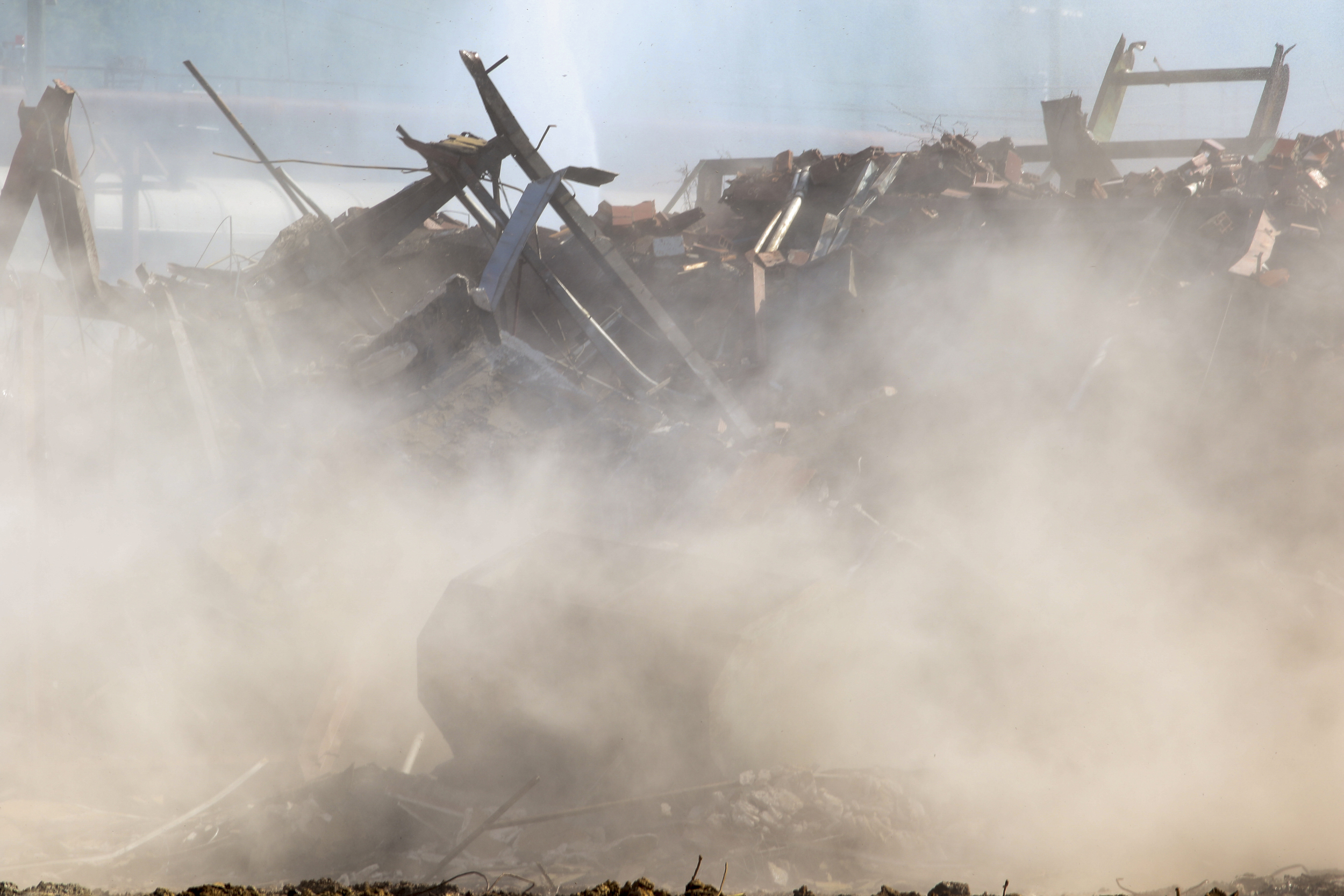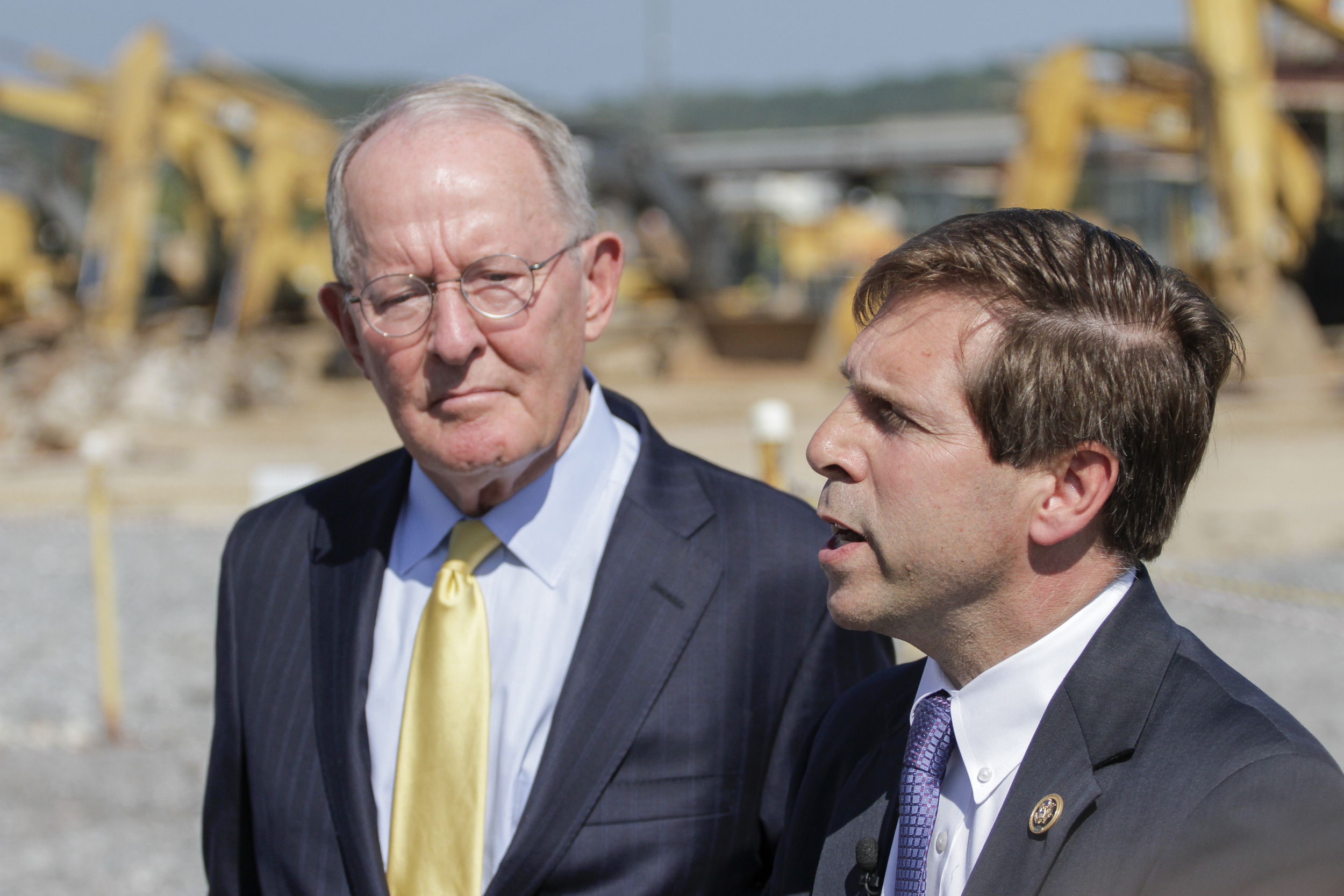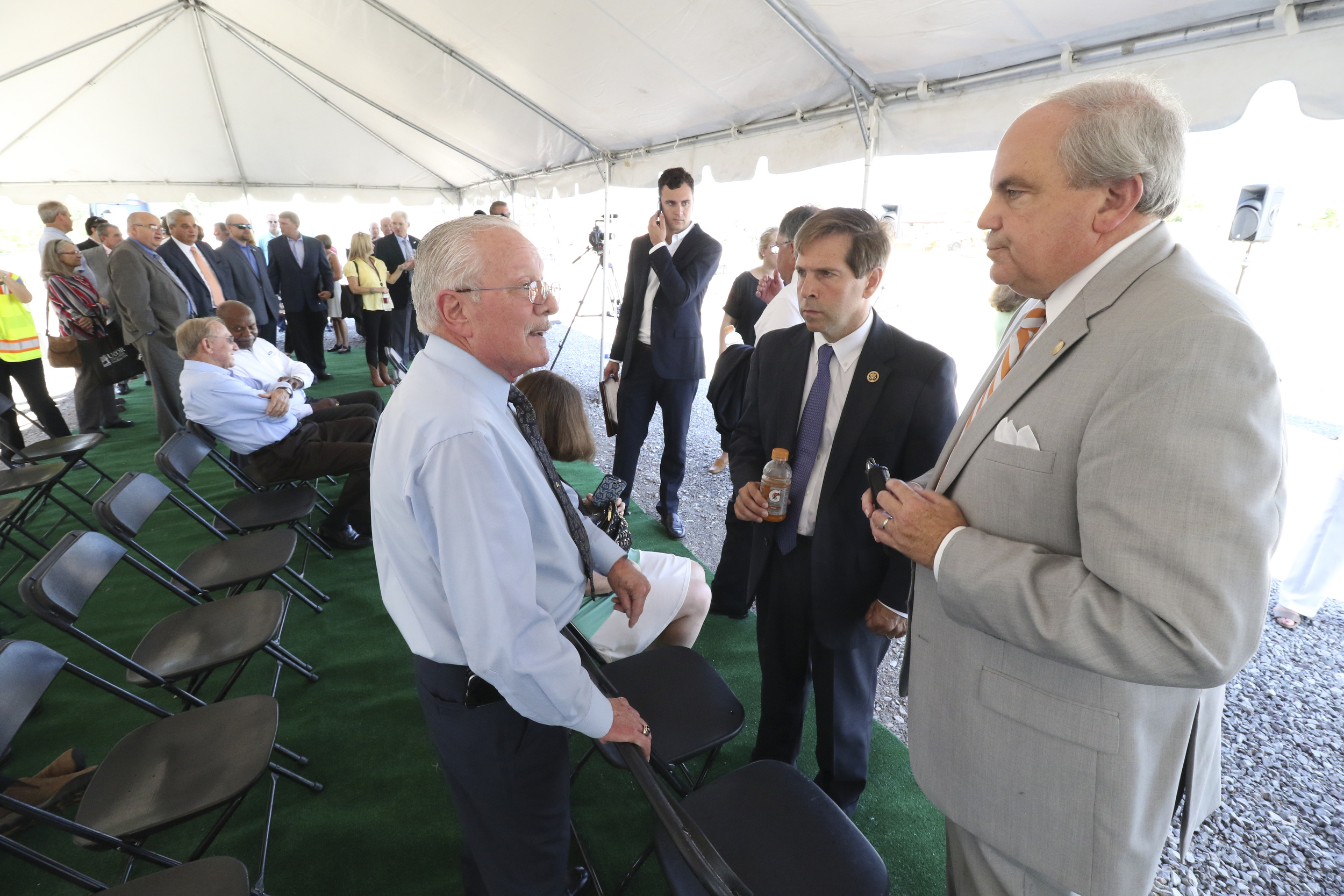OAK RIDGE, Tenn. - The orange-colored bucket on the huge earth-moving excavator seemed to hesitate Tuesday morning as it got closer to what remained of the four-story K-27 building here.
Then the excavator's operator clamped the bucket's jaws around an exposed steel beam near the top of the structure and tugged, almost gently.
First, almost imperceptibly and then faster as gravity took over, the entire wall leaned forward and fell, with a crash, sending up a low cloud of dust to the sound of applause from the crowd of dignitaries, demolition workers, and other Oak Ridge staffers watching nearby.
With the wall's collapse, the most visible physical reminder of a fabled part of America's military and civilian nuclear program was gone.
The heavily contaminated metal from the equipment inside the plant was removed over the previous two years and shipped to a waste storage facility in Nevada, according to Bob Leonard, project manager for UCOR, the contractor overseeing the cleanup.
"We completed Vision 2016 ahead of schedule and under budget," said UCOR President Ken Rueter, referring to the Energy Department's goal of removing all five of the gas diffusion buildings, in what is now the East Tennessee Industrial Park, by the end of 2016.
U.S. Sen. Lamar Alexander, R-Tenn., also praised the demolition.
"More than 720 acres of land and 332,000 square feet of building space has been made available for new economic development," he said.
Building the bomb
K-27 was one of five buildings where a toxic gas called uranium hexafluoride was slowly filtered to help produce bomb-grade U-235 for the U.S. nuclear weapons arsenal. Nearby, K-25 produced material for the bomb nicknamed "Little Boy" that destroyed the Japanese city of Hiroshima on Aug. 6, 1945. That blast, along with another in Nagasaki three days later, using a different bomb design, is credited with ending World War II in the Pacific.
The story of how that material was produced seems astonishing now - dozens of scientific and engineering breakthroughs were achieved in only four years and then a frantic construction project erected a secret city sheltering the most advanced industrial plants in the world that produced sufficient bomb-grade material in just a few months.
Even more remarkable, the entire process of building the atomic bomb, known as the Manhattan Project, was guided by an elite group of theoretical physicists allied with a handful of visionary military leaders - in particular, Gen. Leslie Groves - in tandem with some of the nation's most advanced industrial companies in a unique partnership never seen before or since.
U.S. scientists believed they were in a race against Adolf Hitler's own corps of nuclear researchers and they were not even certain they could build an atomic bomb until the late 1930s.
The basic idea seemed simple enough - if sufficient uranium of a certain isotope, U-235, was packed together closely enough, it gave off immense heat. If it could be purified even further and suddenly packed even tighter, it would start a devastating chain reaction - an atomic bomb.
 Officials, media and nearly 1500 employees watch as Garrett Meek uses a large track hoe to bring down the final wall of the Building K-27 at the East Tennessee Technology Park in Oak Ridge, Tenn., on Aug. 30, 2016. According to Bill Williams, with the U.S. Department of Energy, this marks the first time in world history that all of a site's uranium enrichment gaseous diffusion buildings have been cleaned and demolished.
Officials, media and nearly 1500 employees watch as Garrett Meek uses a large track hoe to bring down the final wall of the Building K-27 at the East Tennessee Technology Park in Oak Ridge, Tenn., on Aug. 30, 2016. According to Bill Williams, with the U.S. Department of Energy, this marks the first time in world history that all of a site's uranium enrichment gaseous diffusion buildings have been cleaned and demolished. Enriching uranium
The amount of material needed was not that large - the bomb dropped on Hiroshima contained about 130 pounds of U-235.
But how to purify the material? Natural uranium is made up almost entirely of the U-238 isotope, but it also includes less than 1 percent of U-235.
Several methods were tried to extract the U-235 and enhance it, but in the end, they were combined. Uranium would first be enriched in one facility then used as feed material for another, where it would be further enriched, and then sent to yet another.
Building K-25 focused on gas diffusion. Isotopes of U-235 would be separated from U-238 by taking uranium hexafluoride gas and pumping it through some form of barrier material that had millions of microscopic holes and would filter out the U-235. But a workable barrier material had not been invented.
A few miles away the Y-12 site tried a different approach, using electro-magnetism. The world's second atomic reactor (after the one Enrico Fermi built at the University of Chicago in December 1942) was constructed at the X-10 site to produce plutonium for a bomb. And the S-10 site tried yet another method, liquid thermal diffusion.
Each plant was itself an attempt to take the latest research in theoretical physics and bootstrap it into an actual functioning plant in a matter of months, not years. And each had major engineering challenges that at times during 1944 made it seem unlikely their theoretical potential would ever be realized.
And then there were the practical concerns. Construction of the Y-12 plant, for example, required 38 million board feet of lumber. The magnets needed so much copper the U.S. Army had to borrow 15,000 tons of silver bullion from the U.S. Mint as a substitute, according to the Atomic Heritage Foundation.
When completed, K-25 was a mile long and covered 42 acres, bigger even than the Pentagon, at the time the largest building in the world. The cost was $512 million, more than $6.5 billion in current dollars.
The overall site, on 59,000 acres 20 miles west of Knoxville on the Clinch River, was named the Clinton Engineering Works.
Building the Secret City
The Oak Ridge area at the time was rural, with valleys bordered by low ridges. The location was chosen in part because if there should ever be an explosion at the site, the ridges would help to dampen the impact of the blast.
The initial plan was for 30,000 people, but by 1945, the population was 75,000, according to the Atomic Heritage Foundation.
Because the facilities needed a secure supply of electricity, a power plant was built beside the Clinch River in less than eleven months. At one time, the plants were consuming one-seventh of all of the electricity produced in the U.S.
While K-25 was being completed, work started on K-27 in early 1945, and later on companion facilities K-29, K-31 and K-33.
In early August 1945 came the startling story of the atomic bomb and for the first time, east Tennesseans and the rest of the world realized what had been going on in the never-to-be-mentioned labs outside Knoxville.
Peacetime uses of the atom
K-25, K-27 and the other diffusion buildings continued to produce enriched uranium for many more years. After the war ended, Oak Ridge's facilities produced the majority of bomb grade U-235 for the U.S. arsenal throughout the Cold War with the Soviet Union. Until 1985, the K-25 plant produced fuel for reactors in the U.S. and elsewhere.
But eventually, a new method for concentrating uranium was developed, involving centrifuges. It is that method, with large groups of spinning machines, that has been a key issue in the U.S. treaty with Iran that restricts that country's ability to produce material for nuclear weapons by limiting the number of centrifuges it can operate.
Oak Ridge itself was shifted to civilian control two years after the war ended. More research facilities have been added over the years, and now the U.S. Department of Energy manages the Oak Ridge National Laboratory at the site.
The Department of Energy began demolishing the abandoned gas diffusion buildings in 2006.
Even after the last building is toppled and removed, a physical reminder of the plants will remain. The diffusion equipment from the buildings, already hauled to Nevada, is contaminated with U-235, which is one of the longest-lasting radioactive isotopes.
U-235's half-life, the time it will take for it to lose half of its radioactivity, is more than 700 million years, "and we will need 10 half lives to get it down to a safe level," said UCOR's Leonard.
Contact staff writer Steve Johnson at 423-757-6673, sjohnson@times freepress.com, on Twitter @stevejohnsonTFP, or on Facebook, www.facebook .com/noogahealth.

